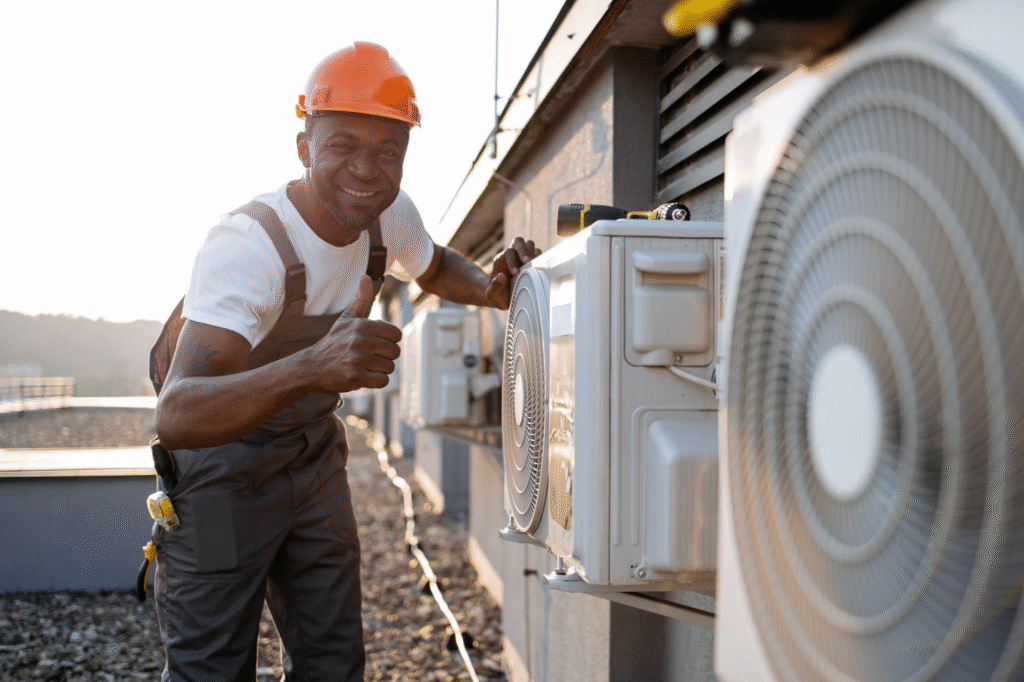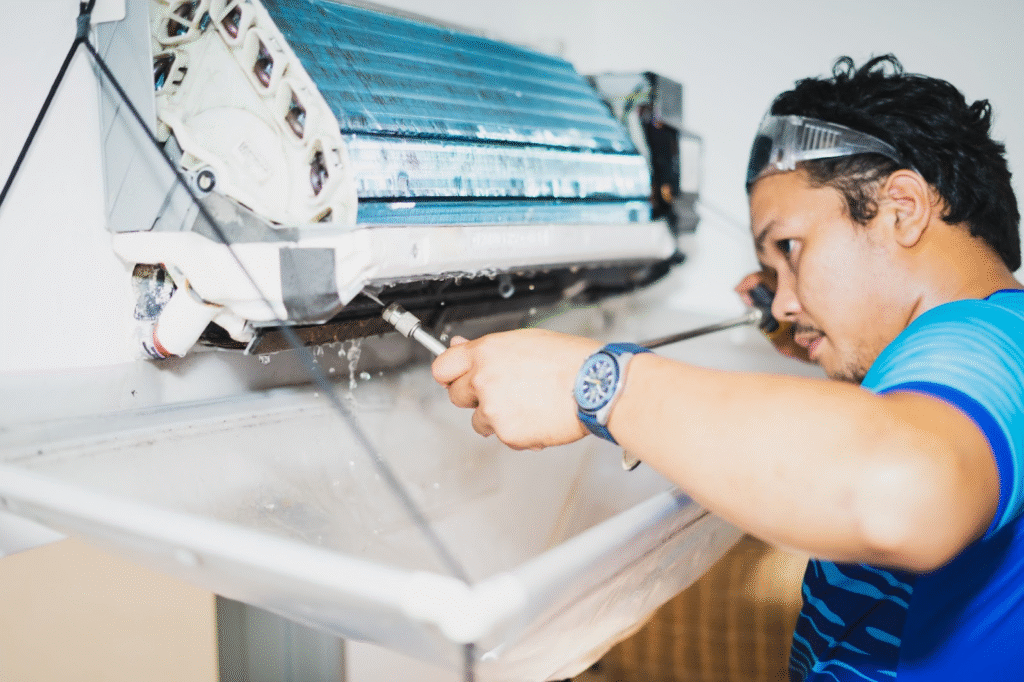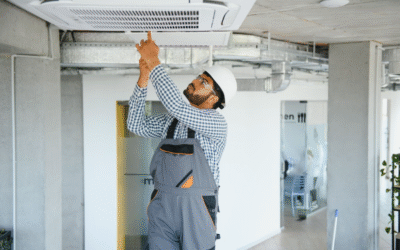The Most Common Problems That Require AC Repair Services

A cooling system rarely fails all at once. More often, it sends a string of warning signs—uneven temperatures, odd noises, short cycling—that hint at deeper issues. Knowing the most common problems helps you act before a minor inconvenience becomes a midsummer emergency. Below are the common trouble spots technicians encounter daily and how an AC repair service typically addresses them.
When AC Repair Service Addresses Warm Air and Uneven Cooling
Warm air from the supply vents usually traces back to airflow or refrigerant problems. Clogged filters, collapsed return ducts, or a slow indoor blower choke the system, forcing longer run times while rooms stay muggy. A low refrigerant charge from a small leak can mimic the same symptoms, but you’ll also notice that the coil is colder than it should be, and the humidity never quite drops. A qualified AC repair service will verify airflow, measure static pressure, examine duct integrity, and then check superheat and subcooling to determine whether the system’s charge is correct or a leak search is needed. Catching this early protects the compressor from overheating and restores comfort without guesswork.
AC Repair Service for Frozen Evaporator Coils
A sheet of ice on the indoor coil may look dramatic, but it’s the result of a simple imbalance: the coil is absorbing less heat than it was designed to. That can stem from a starved return, a dirty filter, a sluggish blower motor, or a low refrigerant condition. Once the coil freezes, airflow drops to nearly zero, and the system can’t cool at all. A technician will thaw the coil safely, correct airflow, and confirm the refrigerant circuit is healthy before restarting.
Airflow Restrictions
Frozen coils often point to dust-choked filters, blocked returns, or closed supply registers. Clearing the path restores heat exchange quickly.
Low Refrigerant Charge
Undercharge lowers coil temperature below freezing. A proper AC repair service finds the leak, fixes it, and charges according to manufacturer specs.
Noisy Operation? AC Repair Service Finds the Source
Air conditioners shouldn’t call attention to themselves. New rattles, squeals, or hisses are diagnostic clues you shouldn’t ignore. Noise usually indicates that a component is loose, worn out, or experiencing abnormal pressure. Rather than masking the sound, a technician tracks down the source so the underlying fault doesn’t escalate into a larger, more expensive failure.
Rattling and Vibrations
Loose panel screws, fan shroud fasteners, or outdoor unit feet can vibrate like a drum. Tightening and re-leveling the cabinet will protect its wiring.
Grinding or Screeching
Dry or failing fan motor bearings and misaligned blower wheels create high-pitched alarms. Prompt service prevents motor burnout and collateral damage.
Hissing and Bubbling
These can indicate refrigerant leaks or equalizing pressures after shutdown. A proper test confirms whether it’s a harmless sound or a sealed-system issue.
AC Repair Service That Stops Short Cycling and High Bills
Short cycling—rapid starts and stops—burns energy and shortens compressor life. It can be caused by an oversized system, a dirty coil that spikes head pressure, a weak capacitor, or a misreading thermostat placed in direct sunlight. An AC repair service will measure run times, inspect capacitors and contactors, clean coils, and evaluate thermostat placement and settings to ensure optimal performance. They may also examine static pressure and duct sizing; if airflow is too low, the system overheats and trips safety controls, forcing it to restart. Fixing the root cause lengthens cycles to the sweet spot where comfort improves and utility bills fall.
Electrical Headaches Demand AC Repair Service
Electrical faults rarely stay small. A pitted contactor that welds shut, a swollen capacitor, scorched wire lugs, or a fatigued fan relay can cascade into compressor or blower failure. The first sign is often intermittent operation—everything works, then suddenly doesn’t—especially under heavy load. A technician checks voltage drop, tightens lugs, tests microfarads on capacitors, and inspects control boards for heat stress. Replacing a $20–$60 electrical part at the right moment can save a four-figure component downstream.
Capacitors and Contactors
Weak capacitors cause hard starts and dim lights; worn contactors chatter or stick. Quick replacement stabilizes, starts, and extends motor life.
Thermostat Miscommunication
Old or miswired thermostats send erratic signals. Correct staging and clean connections restore consistent cycling and comfort.
AC Repair Service for Water Leaks, Musty Smells, and Drain Clogs
Condensate management is easy to overlook until a ceiling stain appears. When the drain pan overflows from algae growth or a sagging line, you get water damage and musty odors. An AC repair service cleans the trap, treats algae, clears the line with nitrogen or vacuum, and verifies the slope so water flows freely. If you have a condensate pump, the float switch and check valve need testing, too. Addressing moisture isn’t just about mess prevention; it helps indoor air quality by removing a breeding ground for mold and bacteria that recirculate through the home.
Weak Airflow and Hot Rooms? AC Repair Service Looks at the Ducts
Not every comfort problem is inside the box. Leaky or undersized ducts can starve a great system: crushed flex, long runs without balancing dampers, or disconnected boots waste cooling in the attic. Technicians measure total external static pressure, compare it to blower tables, and then smoke-test or pressure-test the duct system. Sealing, adding returns, or upgrading restrictive grilles can unlock capacity you already own. Many homeowners are surprised that improving ducts can eliminate hot-and-cold spots without the need to replace equipment.
Indoor Air Quality Gets a Boost With AC Repair Service
Dusty rooms, lingering odors, or allergy flares may not require a gadget; they often point to fundamental maintenance gaps. When airflow and filtration are dialed in, the system removes particulates and humidity more effectively, making the home feel cooler at higher setpoints.
Filter Neglect
Overdue filters reduce airflow and allow bypass around the frame. Right-sized, regularly changed filters protect coils and lungs alike.
Ductwork Leaks
Return leaks pull attic dust and insulation fibers into the system. Sealing returns first yields big air quality and efficiency gains.
Refrigerant Circuit Repairs Require a Skilled AC Repair Service
The sealed system is where DIY efforts typically end. Diagnosing low charge versus a restriction requires gauges, temperature clamps, and experience reading the numbers in context. If a leak is present, a tech will isolate the circuit, repair or replace the faulty component, pull a deep vacuum to remove moisture and air, and weigh in the correct charge. Skipping steps invites acid formation and future compressor failure. A careful AC repair service will also look for the “why” behind the leak—vibration, rub-outs, or corrosion—and address it so you aren’t topping off again next season.

Everyday Problems an AC Repair Service Solves Before They Snowball
When something feels even slightly “off,” a trusted AC repair service can zero in on the root cause by checking airflow, coil cleanliness, electrical parts, refrigerant charge, and drainage. Tackling these issues promptly helps you spend less on energy and repairs, stay comfortably cool, and extend the life of your equipment.
Visit the Cooling & Heating Repair blog to learn more about how proactive AC repair service can minimize costs and keep your system running for longer.
Categories
- AC installation
- AC Installer
- AC Repair
- AC Repair/Heater Repair
- AC System Maintenance
- Air Conditioning Repair
- Air Conditioning Services
- Appliance Repair
- Furnace Repair
- Heater Repair
- Heater Repair Services
- Heating Services
- HVAC
- HVAC and Appliance Repair Services
- HVAC Installation
- HVAC Services
- Promotion
- Thermostat installation
- Uncategorized




